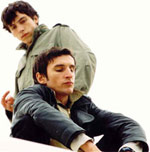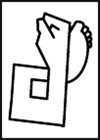HOW I KILLED A SAINT

About the film
Interview by Richard Lormand
HOW I KILLED A SAINT takes place in early 2001. The main character of Viola returns to Skopje to discover that tension has reached a high point and armed conflict has started between the Macedonian army and the newly organized NLA (Albanian Liberation Army), formerly the UCK.
I originally had the idea for the film when I returned home after living several years in the US. I remember arriving to Skopje airport, waiting at the baggage carousel and being surrounded by young military personnel with expressions just as scared and bewildered as mine. I noticed two men dressed in bright orange. Puzzled by the brilliance of the color, I stared at them. When they walked away, I discovered “Mine Technician” written on their backs. Then the ride to Skopje, gray and gloomy, beautiful mountains surrounding the view. This is what I tried to capture at the beginning of HOW I KILLED A SAINT, when Viola is riding in the car home from the airport.
Not only in Macedonia
Obviously, stories of conflict are not restricted to Macedonia. There have been and still are enormous tragedies throughout the world. I didn’t make HOW I KILLED A SAINT to analyse the Macedonian problem. The film is situated in Macedonia because that’s where I’m from and what I know best. But I tried to focus on the universal ideas of the hardship, confusion and ambiguity that war situations bring. I think Macedonia can be seen as a small-scale representation of today’s world. Because of its small size, it is easy to pinpoint all the negative aspects we have created.
Macedonia today
Things have settled, but one cannot dismiss the possibility that occasional bomb blasts or border incidents could develop into more serious conflict. The Western part of Macedonia is a no man’s land still under NLA control. For the area’s some 100,000 refugees, safe conditions for their return has still not yet been established. After the war, a new constitution was drafted to give more rights to the various ethnicities of Macedonia. On paper, we have a great chance for establishing a just society.
Young Macedonians
At the risk of painting a depressive portrait of my country, I think of Macedonia as this vacuum space of 200 km by 250 km (the relatively actual small size of the country). A space that one can never leave. There are two kinds of young people in Macedonia: those who leave when the opportunity arises and the others, who dream of leaving but don’t have such luck. Over the past 15 years, the actual number of young people who have left Macedonia is enormous. For those who remain behind, I’m sad to generalize that there is great scepticism that the future will bring better things. In HOW I KILLED A SAINT, I believe the dilemma of staying or going applies to all the young characters, whether they are ready to admit it or not.
Dreams of a better world
In HOW I KILLED A SAINT, the character of the brother, Kokan, is basically a kid with dreams of a better world. But there is a duality to his character. He isn’t quite sure whom he should fight against: neo-colonialism, Nato forces, his country’s politicians or the religion that nurtures nationalism and divides his country in half. Kokan’s frustration with and dissatisfaction of society and family trouble is exteriorised into the extreme actions he takes. He is like a time bomb ready to blow.
A world free of pacemakers with guns
There is a recent saying in Macedonia that goes something like this: “It’s easier for the Iraqis. At least they know by whom they are occupied. For Macedonians, nothing here is as clear as that.” Macedonia is occupied by many, but mostly by us. Like many countries, it’s one that is ruled by politicians who solely fend for their own financial interests when deciding on national matters. Corporate business tends to govern decision-making in Macedonia. The transition to capitalism opened doors to neo-colonialist enterprises more than it established a just democratic society. To this day I do not believe that our war was ever a war of the people. I made HOW I KILLED A SAINT in reaction to corrupt politicians, war profiteers and international organizations everywhere that don’t always end up protecting the interests of the people. The film is also a call for a world free of peacemakers with guns.
Shoot stopped by NATO
One incident of the shoot proves that life is often much more dramatic than art. Our shoot was stopped by NATO soldiers, who held the crew at gunpoint for more than two hours. The incident happened on the day we shot the first scene of the film, when Kokan positions the “NATO GO HOME” banner over the highway. Some NATO soldiers unaware that a film was being shot took offence. After unsuccessfully trying with the local police to stop the shoot, they decided to take action themselves.
I remember suddenly some 50 soldiers surrounded the crew. We could not afford to lose a shooting day, so Labina sneaked away carrying the film footage with her, while me and Alain, the DOP, drove away with the camera. At first no one was quite sure what was really going on. The whole crew was interrogated. The footage was demanded for examination. While the incident was not so shocking to the Macedonian members of the crew, the international members were quite scared. Being held at gunpoint in a foreign country doesn’t happen everyday. In the end, everything turned out fine. NATO headquarters apologized the following day and promised not to bother us again.
Close to home
Speaking on such a subject so close to home made this journey exceptionally difficult for me. Most of the scenes in HOW I KILLED A SAINT are based on true experiences of my brother Vuk and myself. For example, the film’s bus scene between brother Kokan and sister Viola was developed from something I experienced. A week after fighting started in March 2001, I found myself on a bus rushing 200 km an hour through the war zone. I had heard stories of individuals hit by stray bullets. I never got the courage to get off the bus. Instead, I returned to my parents’ apartment in Skopje.
Not a video game
I will never forget the days that followed war being officially announced on March 20, 2001. Our whole family sat in front of the TV, waiting for news of the fighting which was only 20 km away.
The situation was absurd, abstract. We watched the war on TV as if it was a video game. But all we had to do was look out the window to see the war right in front of our eyes. Rising smoke was seen nearby, gunshots echoed, helicopters hovered above. I remember thinking how different this was from how I seen war represented before. There was no blood. Only sounds, fear and a family gathered, holding hands and waiting for what could be the end.
It also happened that war was announced on the same day of the scheduled Skopje premiere of my short film VETA. It was the strangest feeling since VETA speaks of 10 passengers on a bus running away from a war-stricken land. I remember people reacting to my film by saying this would never happen here. Unfortunately, it did.
Questioning myself
Because the subject matter was so close to me, I had to learn to always question once, twice, three times my initial reaction to every given situation. Our Balkan tragedy taught me this. In any given conflict, everyone speaks of his/her truth and everyone is right. The question never is and never should be about who is right. It should be about finding a solution for all parties concerned. I believe there is always some solution.
A family affair
Labina and I, along with our brother Vuk, contribute to each other’s creations, in all ways possible and when needed. I have to say that my sister Labina is my angel. She is actually the pillar of the partnership between the three of us. She’s the one who keeps things clear and sane.
To this day I do not understand how she managed both acting and producing on HOW I KILLED A SAINT. We entered production with hardly a dime and our parent’s apartment as bank collateral. She is extremely frank and, although it was sometimes painful for me, she was often critical of my work as a writer/director. Labina can also be an extremely stubborn actress at times. I respect and admire her spirit, and I accept her fight for her vision of the character of Viola.
– Teona Strugar Mitevska, director




